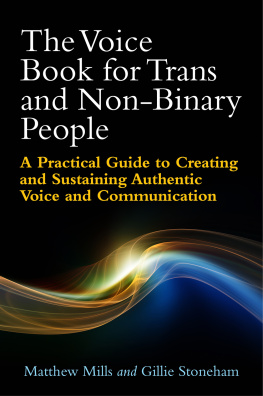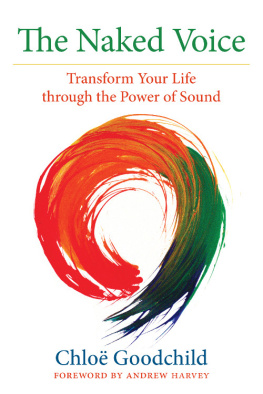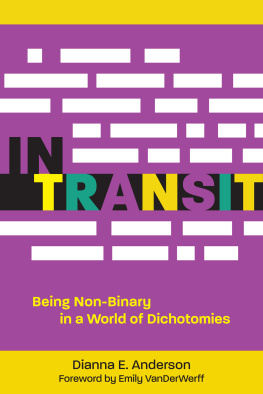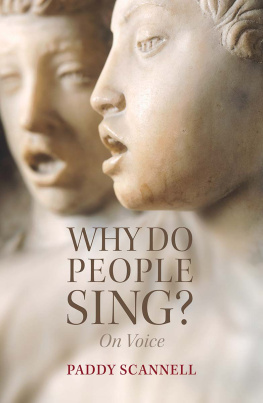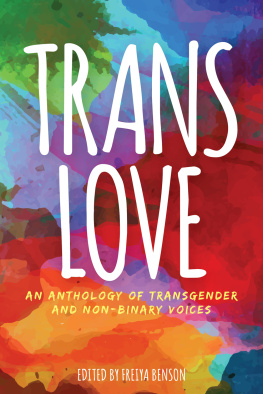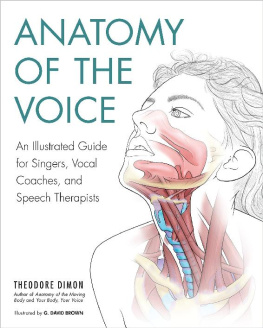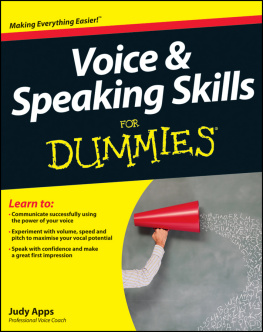
The Voice Book for Trans and Non-Binary People
A Practical Guide for Creating and Sustaining Authentic Voice and Communication
Matthew Mills and Gillie Stoneham
Illustrations by Philip Robinson
Graphics by Matthew Hotchkiss
The accompanying videos can be downloaded from
www.jkp.com/voucher using the code MILLSVOICE

Jessica Kingsley Publishers
London and Philadelphia
Contents
Preface
In writing this book, we acknowledge the rich history and tradition of voice practice that has emerged from more than one discipline: the wealth of expertise shared by many teachers and authors who have in turn inspired us in our own work. In setting out a comprehensive exploration and programme of practical exercises, what we offer here is our combined experience as speech and language therapists and voice coaches. While tailoring the content specifically to trans and gender diverse people, we set voice work within the context of the whole person, seeking authenticity and integration. We offer the reader something very practical in the spirit of fostering self-efficacy: in helping people to master their own vocal instrument and communication style, we welcome our own redundancy as therapists.
Collaboration has been at the heart of writing this book. It has been a process of deep learning and pleasure to sit, share and reflect on our practice together. It has been inspiring to learn from the many stories and lived experiences of those who have come to consult with us: those who, like the reader, are central to this book.
We are grateful to so many who have helped us. Thanks particularly to: Philip Robinson for the life in his illustrations; Matthew Hotchkiss for the clarity in his diagrams; John Stack for impromptu technical support; Niall Towl, Simon Fairhead and the team at TellyJuice for their sensitive work; Jeannette Nelson, Bren Brown and Ursula Le Guin for permission to use their quotations as epigraphs; Jan Logan, Amanda Redstone and Mark Hayward for their affirming narrative conversations; friends who generously gave up their spare rooms in providing sanctuary to think and write; and above all thanks to those who have come and shared their insights and wisdom, and offered us all learning without end
Introduction
Who is this book for?
This book is primarily for trans and gender diverse people who are seeking information, guidance and insider accounts on exploring voice and communication related to gender identity. It may be of interest to their families, friends and significant others who are supporting them. It is also intended as a supportive text for speech and language therapists/pathologists and voice coaches who are starting out or continuing on their journey of affirmative clinical practice with trans and gender diverse people. It may also be a useful additional text for other gender specialist professionals wishing to learn more about approaches to trans and non-binary voice and communication therapy and its intersection with other disciplines such as psychology, and to read the lived accounts from the very people who can impart this knowledge from the inside.
Collaboration at the heart of the book
The central tenet of the book is that voice is absolutely integral to our identity. Indeed, nothing is more important to any of us than our identity our sense of self through which we come to understand our deepest values and strongest beliefs, our hopes, intentions and commitments in life. Expressing these as part of who we are is therefore an essential part of interacting with the world. It is for this reason, when asked to write this book, that we came immediately to the conclusion that producing a manual or how to guide had to include the lived experience of the people with whom we have worked. We offer our expert opinion, grounded in clinical experience, as a starting point to the journey, knowing that this is only one part of the jigsaw. We felt that the trans and non-binary voice, in its political sense as well as the more practical one, needed to be at the very centre of this work.
With this philosophy at the heart of the book, we asked the people with whom we have worked questions about what was most useful in learning about voice and communication, both in and outside the therapy sessions, what has helped them most, and what continue to be the challenges on the journey towards comfortable gender expression with those they encounter in everyday life. We also asked them what they might share with people entering into a similar process. In setting out to ask them what works and has worked, we were acutely aware of the cultural discourse that tends to privilege the therapists expertise over client contribution when evaluating therapy. This is what pioneering family and narrative therapist Michael White called privileging the micro world of therapy over the macro context of clients lives (Redstone, 2004, p.2; see also White, 1997b). Instead, we wanted to centre the contribution and determination of those who came to consult with us. So we present a collaboration in which our approach to trans and non-binary voice and communication therapy is interwoven throughout with the reflections of people with whom we have worked, past and present. Some people used personal metaphors and imagery to richly describe aspects of the change process, all of which provide insight into exploring voice and communication. The insider knowledge and skills of the people with whom we consulted is evident in the many stories of their individual journeys towards voice and communication congruence. We hope that you will find them as enlightening and educational as we did, and that the whole book sparks new reflections on your own knowledge and skills in trans and non-binary voice and communication. The people with whom we worked have generously given permission to publish their reflections from interviews conducted with them and these appear throughout the book in a different font. We wanted comments to be clearly attributed, so names of interviewees are recorded where consent was given, or pseudonyms used where preferred.
Jane (on starting out): When I started thinking about my voice about five years ago, I looked around and there were no voice therapy books for and involving trans people with stories of peoples actual experiences to guide me, and that was frustrating.
Talen (on charting new territory): This has not been done before. Its a coming together of therapist expertise and trans peoples actual experience of doing the therapy and reporting on how useful and challenging it is. We have insider knowledge because we are doing the voice therapy, and therapists have other insider knowledge based on their clinical experience sharing these perspectives creates something very worthwhile for all of us. It feels very important and timely to be collaborating in this way.
Col (on working together): Sharing and collaborating and reflecting on how we are doing is at the heart of this, and our progress.
A word about terms
We take our lead from discussions with the people we work with and supervision with our colleagues. It is our intention to use safe, or safer, terms and be mindful of the varying impact that even well-intended words can have (see Richards and Barker, 2013, for an in-depth discussion). We acknowledge that everyone is an individual, each with a unique history and set of values, beliefs and things they hold dear. For this reason, we use trans rather than transgender as it is a more community acceptable term and is seen as less medicalising or pathologising of the individual. We understand the individuality of everyones journey and use trans and non-binary voice in the context of exploring vocal change or effective communication as part of a process and movement towards gender comfort.
Next page
